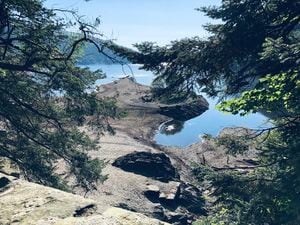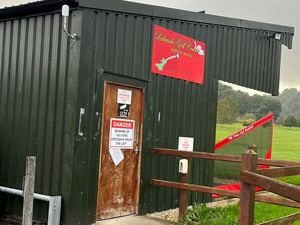Hidden submerged village revealed due to Lake Vyrnwy's low water levels
Not one of us can remember a time when Lake Vyrnwy was anything but that - a beautiful lake with its trademark dam and Victorian straining tower at one end.

Yet the incredibly low water levels at the reservoir are revealing the remains of some of the houses that used to line the valley.
Today the village of Llanwyddyn stands proud above the water.
But these are houses built after the construction of the Lake Vyrnwy.
Normally the reservoir, built in the late 1800s to provide water for Liverpool, would be about 87 per cent full at this time of year. Last year it was 77 per cent full. But this week is dropped to just over 60 per cent full.
And while this is worrying amid the UK-wide dry weather, it has brought a fascinating sight for local people and tourists alike.
Visitors to the reservoir can clearly see what is left of one of the old bridges that once crossed the valley along with old dry stone walls and even some of the foundations of the homes that people had to leave to make way for the huge engineering project.
John Yossarian went down to see the low water for himself taking a photo of old foundations.
The photos shows the south wast side of the lake.
"You can see the road leading into the drowned village as the exposed terrain in the upper left. It was drowned in 1888. The leaves in the tree furthest from shore is usual height even in normal summer level."
The last time the lake revealed its past in detail was in the drought of 1976.
Simon Baynes, now an MP for neighbouring Clwyd South, lived at Lake Vyrnwy Hotel growing up and remembers 1976 well.
"Much of the old village was revealed as the water level of the lake went down dramatically. You could see an old bridge, street patterns and a large millstone. I often think fondly back to that summer when I was 16 and it was such a pleasure to live at beautiful Lake Vyrnwy Hotel."
It was in 1877 that the city engineer of Liverpool investigated the possibility of damming the River Vyrnwy to create a reservoir for the ever-expanding city of Liverpool. When surveys discovered a natural bed of rock when the valley began to narrow it was decided that it would be an ideal site. The Liverpool Corporation took the enormous task.
Trial shafts were put in the following year and in 1881 the first stone was laid by the Earl of Powis to commemorate the start of the work.
Homes and the church were demolished and new ones build about the planned water level.
At its peak there were 1,000 men working on the creation of the reservoir and by 1888 work was complete and the valley left to flood.
This took just a year and in November 1889 water flowed over the dam.
Alongside the construction of the reservoir itself a pipe had to be sunk from the reservoir travelling 68 miles, across mid Wales, parts of Shropshire and onto Liverpool. It was 1892 when people in Liverpool had their first taste of Vyrnwy water.
It also had an added benefit of the water being used to generate electricity for Llanwddyn until 1960 when the village was connected to the mains.
Following the Water Act of 1974, Lake Vyrnwy and the estate passed from Liverpool Corporation to Severn Trent Water Authority.
Llanwyddyn resident, Julie Williams said the old village that had to make way for the reservoir should never been forgotten.
"It is very sad that the locals had to move out. That is part of our history and it is fascinated to see was is left today. You can see loads of the roads that went down to the village and walls that would have been around fields. The old bridge at the entrance to the village is also out of the water."





